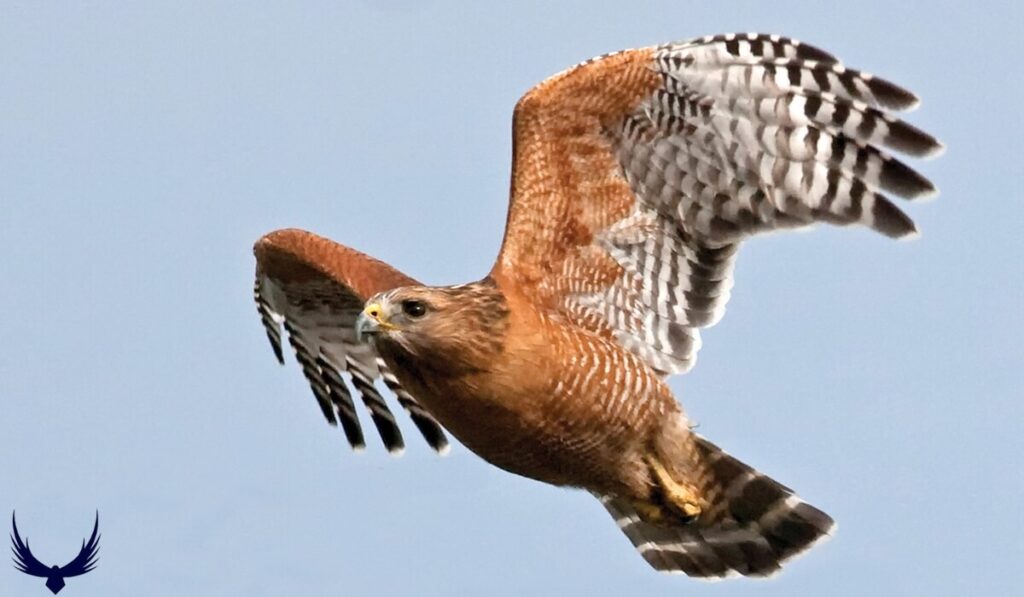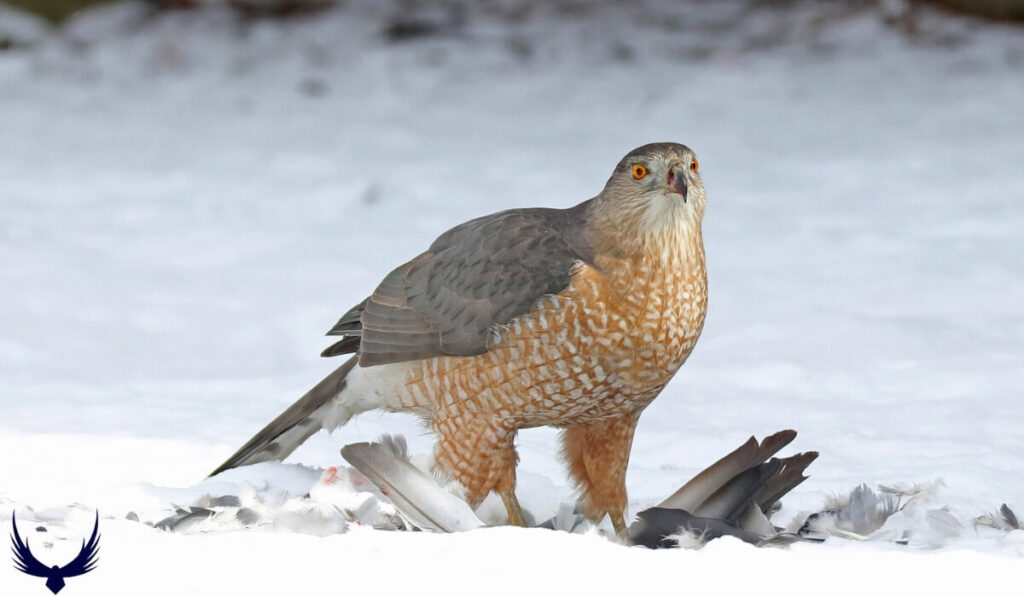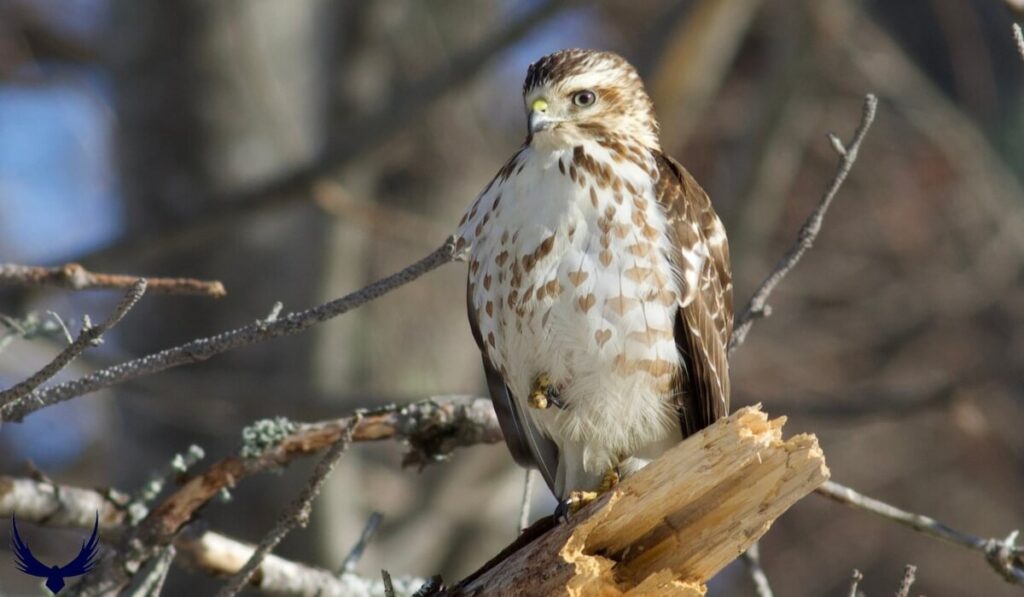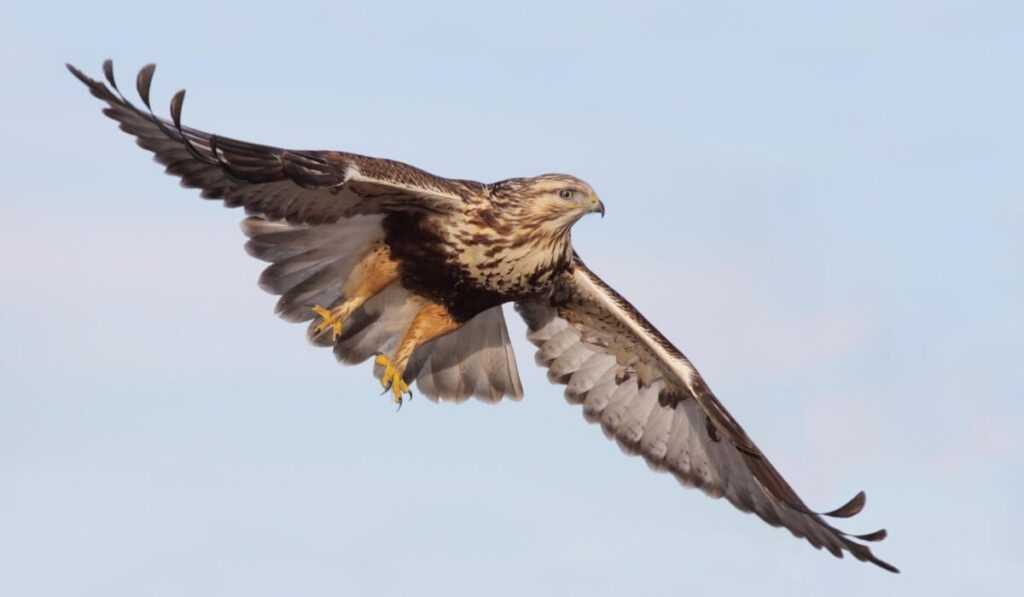In Georgia, hawks are common in the sky, with their sharp eyesight and hunting skills. Different types of hawks like the Broad-Winged Hawk and Red-Tailed Hawk can be seen in various habitats across Georgia.
In this article will talk about types of hawks in Georgia, where to see them, how to recognize them, and some cool facts about these amazing birds.
7 Types of Hawks in Georgia
Georgia has many different types of hawks. They are adapted to different habitats. Hawks in Georgia vary in sizes, colors, and behaviors. For example, there is the small and quick Sharp-Shinned Hawk, and the bigger and stronger Red-tailed Hawk.
Each hawk species has a special role in Georgia’s ecosystem. They help control rodent populations and keep the environment balanced. Watching these amazing birds in nature can teach us a lot about Georgia’s diverse wildlife and why it’s important to protect it. Here are the different hawks in Georgia:
Red-Shouldered Hawk
- Scientific Name: Buteo lineatus
- Lifespan: 15 to 20 years in the wild
- Length: 16 to 24 inches
- Height: About 1.5 feet when perched
- Weight: 1.1 to 1.9 lbs.
- Wingspan: 37 to 43 inches
Characteristics and Identification
The Red-Shouldered Hawk is a most common hawk in Ggeorgia in the state’s wooded areas and suburban landscapes. This medium-sized hawk is a year-round resident, playing a vital role in Georgia’s ecosystems as both predator and indicator species of environmental health. These hawks of Georgia are known for their distinctive “kee-aah” call.

Red-Shouldered Hawk is easily recognized by its distinctive reddish-brown “shoulders” and heavily barred reddish chest. Its wings display a striking black and white checkered pattern, while its tail features narrow white bands alternating with broader black ones.
Habitat
Red-Shouldered Hawks in Georgia live in various habitats such as moist woodlands and areas near water. They are found in bottomland hardwood forests, swamps, and in wooded suburban areas. They are most common in the Piedmont and Coastal Plain regions of Georgia but can be seen throughout the state, though they are often more visible during the breeding season.
Feeding Habits
The diet of the Red-Shouldered Hawk is diverse, primarily feeding on small mammals, amphibians, reptiles, and sometimes small birds. Their hunting strategy often involves perching on tree branches and scanning the ground for prey or flying low through the forest canopy in search of a meal.
Breeding Pattern and Conservation
Breeding season for Red-Shouldered Hawks in Georgia is from March to July. They build nests in tree branches and lay 2 to 4 eggs, which both parents care for.
Conservation efforts have helped these hawks adapt to suburban areas and benefit from reforestation. However, they still face challenges from habitat loss and pollution. Protecting their habitats is important for their long-term survival in Georgia.
Related Guide: Types of Hawks in Florida
Northern Harrier
- Scientific Name: Circus hudsonius
- Life span: 4 to 8 years in the wild, Maximum recorded is 16 years
- Length: 16 to 20 inches
- Height: About 18 inches when perched
- Weight
- Males: 12 to 18 oz
- Females: 15 to 28 oz
- Wingspan: 40 to 46 inches
Characteristics and Identification
The Northern Harrier, also known as the Marsh Hawk, is a distinctive raptor that can be observed in Georgia during the winter months. This medium-sized hawk is unique among North American raptors for its owl-like face and low-flying hunting style.
In Georgia, Northern Harriers are winter residents, arriving in the fall and departing in the spring for their breeding grounds further north.

Adults Northern Harrier exhibit sexual dimorphism, with males being gray above and white below, while females are brown above and streaked below.
Both sexes have a white rump patch that is visible during flight. Juveniles resemble adult females but have a rich buffy-orange underside. Their flight pattern is characterized by slow, low glides with their wings in a V-shape.
Habitat
Northern Harriers prefer open habitats such as marshes, grasslands, and agricultural fields. In Georgia, they can be found in coastal marshes, wet meadows, and large open areas throughout the state. Their population in Georgia fluctuates with the seasons, with numbers increasing during migration and winter.
Feeding Habits
In Georgia, Northern Harriers mostly eat small mammals such as voles and mice, as well as small birds, reptiles, and amphibians. They hunt by flying low over open areas using both visual and auditory cues to locate prey. Their owl-like facial disc aids in hearing, allowing them to detect prey hidden in vegetation.
Breeding Pattern and Conservation
Northern Harriers do not breed in Georgia, they play an important role in the state’s winter ecosystem as predators. Conservation efforts focusing on preserving these open habitats are crucial for maintaining Northern Harrier populations during their winter residence in Georgia.
Birdwatchers and nature enthusiasts in Georgia can best observe Northern Harriers from late September through early April, with peak numbers occurring in mid-winter.
Red-Tailed Hawk
- Scientific Name: Buteo jamaicensis
- Lifespan: 10 to 15 years in the wild, can reach up to 25 to 30 years in captivity
- Length: 18 to 26 inches
- Height: About 12 to 16 inches when perched
- Weight: 2 to 3.5 lbs.
- Wingspan: 44 to 53 inches
Characteristics and Identification
The Red-tailed Hawk is one the largest hawk in Georgia and common Michigan bird, present throughout the state year-round. This large, robust hawk is a member of the genus Buteo and is known for its adaptability, thriving in a variety of habitats from forests and fields to urban areas.

Adult Red-tailed Hawks are easily identifiable by their brick-red tail, which gives them their name, though this feature is not present in juveniles. They have a dark brown back, pale underparts, and a dark band across the belly.
Habitat
Red tailed Hawks in Georgia can be found in diverse environments including deciduous and mixed forests, open countryside, parks, and even cities. They are often seen perched high or flying over open areas.
Feeding Habits
These hawks of Georgia are opportunistic predators, feeding on small to medium-sized mammals such as rabbits, squirrels, and rodents. They also eat birds, snakes, and carrions. Their hunting strategy often involves perching on high vantage points and then diving down to catch prey. They can also hunt while flying.
Breeding Pattern and Conservation
Breeding season for these large hawks in Georgia begins in late winter to early spring. The female lays 2 to 3 eggs, which both parents incubate for about 28 to 34 days. After hatching, the young hawks remain in the nest for 5 to 6 weeks before flying.
Red-tailed Hawks are important predators in Georgia, helping to control small mammal populations. They can survive well in changing environments, but they are at risk from habitat loss, accidents with vehicles and buildings, and sometimes being shot illegally.
Birdwatchers can see Red Tailed Hawk in Georgia all year. They can be seen in both rural and urban settings, often soaring on thermals with their distinctive, raspy “kree-eee-ar” call .
Cooper’s Hawk
- Scientific Name: Accipiter cooperii
- Lifespan: 8 to 12 years in the wild
- Length: 14 to 20 inches
- Weight
- Males: 8 to 14 oz
- Females: 13 to 24 oz
- Wingspan: 28 to 38 inches
Characteristics and Identification
Cooper’s Hawks are common hawks in Georgia, found in woodlands and suburban areas. They’re known for their agile flight through dense forests and their habit of hunting smaller birds. These hawks have a distinctive long tail and rounded wings.

Identifying a Cooper’s Hawk in Georgia can be challenging due to its similarity to the smaller Sharp-Shinned Hawk. Adult Cooper’s Hawks have a blue-gray back, rusty barred chest, and a dark cap on their head.
They have long tails with rounded ends and short, rounded wings. Females are notably larger than males. Juveniles have brown backs with streaked underparts, gradually molting into adult plumage over their first year.
Habitat
Cooper’s Hawk is a medium-sized raptor that is a common resident in Georgia. This agile predator is known for its remarkable aerial skills and is a frequent visitor to backyard bird feeders, where it hunts smaller birds like sparrows, chickens, and ducks.
Cooper’s Hawks in Georgia can be found across a variety of habitats, from dense forests to suburban areas. Cooper’s Hawks are present year-round in Georgia, with some seasonal fluctuation as northern birds move south for the winter.
Feeding Habits
The diet of Cooper’s Hawks in Georgia consists of medium-sized birds, such as mourning doves, European starlings, and American robins. They are also known to prey on small mammals like chipmunks and squirrels. Their hunting strategy involves short bursts of high-speed flight through wooded areas, using their agility to navigate through branches and surprise their prey.
Breeding Pattern and Conservation
Cooper’s Hawks breed throughout the state, nesting in deciduous or mixed forests. Nesting occurs from March to June, with pairs often returning to the same nesting area year after year. The female lays 3 to 5 eggs, which hatch after about a month of incubation. Both parents participate in rearing the young. During breeding season, their distinctive “kek-kek-kek” call can be heard as they defend their territories.
Cooper’s Hawks faced population declines in the mid-20th century due to pesticide use and habitat loss, their numbers have since increased in number. In Georgia, they are considered a species of least concern, with stable populations across the state.
Cooper’s Hawks can be seen all year for birdwatchers in Georgia. They perch on tree branches or fly swiftly through wooded areas. Patient observers may spot them hunting near bird feeders or soaring above forest edges. Their presence often alarms smaller birds, indicating a Cooper’s Hawk nearby.
Sharp-Shinned Hawk
- Scientific Name: Accipiter striatus
- Lifespan: Average 3 to 5 years in the wild, can reach up to 12 years
- Length: 9 to 14 inches and males are smaller than females
- Weight
- Males: 3 to 4 oz
- Females: 5 to 8 oz
- Wingspan: 20 to 26 inches
Characteristics and Identification
Sharp-Shinned Hawks are small, fast raptors found in Georgia during migration and winter, known for its swift flight and predatory skills. They are the smallest Accipiter in North America and are often confused with Cooper’s Hawks.
In Georgia, they are around all year, but their numbers increase during fall and winter as northern birds migrate south.

Identification of Sharp shinned Hawks in Georgia can be challenging due to their similarity to Cooper’s Hawks. They have blue-gray upperparts, rusty barred underparts, and a dark cap. Key distinguishing features include their smaller size, more square-tipped tail (as opposed to the rounded tail of Cooper’s Hawks), and a less pronounced head projection when in flight. Females are noticeably larger than males.
Habitat
Sharp-Shinned small hawks in Georgia inhabit a variety of wooded areas, including deciduous, coniferous, and mixed forests. They are also increasingly adapting to suburban environments with sufficient tree cover. During migration, they can be observed in more open areas as they move through the state.
Feeding Habits
Sharp-shinned Hawks are the smallest hawk in Georgia and are known for their hunting small songbirds. Their diet in Georgia consists mainly of species like chickadees, titmice, and sparrows.
Breeding Pattern and Conservation
Breeding behavior of Sharp-shinned Hawks in Georgia is less documented than in northern states, as many individuals migrate north to breed. Some Sharp-Shinned Hawks breed in Georgia, especially in the northern mountains. They nest in dense coniferous or mixed forests, with the female laying 4 to 5 eggs in a hidden nest high in a tree. Both parents participate in incubation and rearing of the young.
Sharp-shinned Hawks face several conservation challenges in Georgia. Their populations have recovered from mid-20th century declines due to DDT use.
Birdwatchers in Georgia can see Sharp-shinned Hawks all year with the best time being during fall migration (September to November). They are often seen flying through forests or hunting at bird feeders.
Broad-Winged Hawk
- Scientific Name: Buteo platypterus
- Lifespan: average 12 years, can reach up to 18 years in the wild
- Length: 13 to 17 inches
- Weight: 9 to 20 oz
- Wingspan: 31 to 39 inches
Characteristics and Identification
Broad-Winged Hawks are medium-sized raptors that migrate and breed in Georgia’s forests during spring and summer. They migrate in large flocks called kettles in the fall. Their presence in the Georgia is most prominent from April through September, with some individuals occasionally overwintering in southern parts of Georgia.

The identification of Broad-winged Hawks is characterized by their short, broad wings, and banded tail. Adults display a dark brown back with a heavily barred chest and belly. In flight, they show a distinctive white band across the tail, bordered by darker bands. Juveniles have a similar pattern but with a more streaked appearance on the underparts.
Habitat
Broad-winged Hawks prefer deciduous or mixed forests in Georgia. They can be found throughout the state but are more common in the northern and central regions in the Appalachian foothills and Piedmont areas. These hawks have adapted well to fragmented forests and can sometimes be observed in suburban areas with sufficient tree cover.
Feeding Habits
The diet of Broad-winged Hawks in Georgia consists of small mammals, amphibians, and insects. They are known for their unique hunting technique of perching quietly and making short flights to capture prey on the ground.
Breeding Pattern and Conservation
During breeding season, pairs engage in courtship displays including spiraling flights and aerial acrobatics. Nesting occurs in forests with the female laying 2 to 3 eggs.
In September and early October, these hawks gather in large groups called “kettles,” sometimes numbering in the thousands, as they begin their journey to South America. This spectacle, known as a “hawk watch,” can be observed at various points in Georgia along ridgelines in the north of the state.
Conservation efforts for Broad-winged Hawks in Georgia focus on protecting large areas of forest, which is important for their breeding success. Their populations are mostly stable, they face challenges from habitat loss due to urbanization and agriculture. Climate change could also impact their migration and breeding patterns in the future.
Birdwatchers in Georgia can see Broad-winged Hawks during their spring arrival in April and May throughout the summer breeding season and during their fall migration in September.
Rough-Legged Hawk
- Scientific Name: Buteo lagopus
- Lifespan: Average 8 years, can reach up to 18 years in the wild
- Length: 18 to 24 inches
- Weight: 1.6 to 3.0 lbs.
- Wingspan: 50to 54 inches
Characteristics and Identification
The Rough-legged Hawk is an uncommon winter visitor to Georgia, not year-round residents. This large, Arctic-breeding raptor spends its summers in the tundra regions of North America and Eurasia, migrating south to more temperate areas including Georgia for the winter.
Rough-legged Hawks in Georgia can be observed from late October through early April, with peak numbers occurring in December and January in open fields and grasslands.

Identifying Rough-legged Georgia Hawks in can be challenging due to their variable plumage and similarity to other buteo species. They have light and dark colors, with light ones being more common. Key features include feathered legs (hence the name “rough-legged”), a pale head and chest contrasting with a dark belly band, and distinctive dark carpal patches on the underwings.
Habitat
Rough-legged Hawks in Georgia prefers open habitats such as fields, grasslands, and coastal marshes. They are mostly found in the northern and central parts of the state. These hawks of Georgia are not evenly distributed and tend to be localized in areas with suitable habitat and prey availability.
Feeding Habits
Rough-legged Hawks in Georgia mainly eat small mammals like voles and mice. They hunt by flying low over open areas or hovering to find prey. Unlike other raptors, they don’t breed in Georgia but come as winter visitors, going back to the Arctic in spring to breed.
Conservation
Conservation efforts for Rough-legged Hawks in Georgia focus on preserving winter habitat, like open grasslands and agricultural areas. Although not in danger, these Georgia hawks face challenges from habitat loss due to urban development and changes in agricultural practices. Climate change may also affect their wintering range and the timing of their migrations.
Birdwatchers in Georgia can see Rough-legged Hawks from November to March. Look for them in open fields in the Piedmont and Coastal Plain regions. You can find them in wildlife areas, wildlife refuges, and farmlands.
Where to Find Hawks in Georgia?
Hawks are common in Georgia and can be observed during daylight hours with some preparation. Good places to spot them include state parks and wildlife refuges, which often have trails designed for wildlife viewing. Some popular locations are
- Red Top Mountain State Park
- Okefenokee National Wildlife Refuge
- Kennesaw Mountain National Battlefield Park
When hawk-watching, it’s important to:
- Stay aware of your surroundings
- Avoid feeding the hawks
- Keep clear of nesting areas during breeding season
Experienced birdwatchers or guided tours can help to identify hawks in Georgia that may be camouflaged or hidden. With patience and respect for wildlife, hawk-watching can be a rewarding experience in Georgia.
FAQs – Hawks in Georgia
Is it Illegal to Kill a Hawk in Georgia?
In Georgia, it’s against the law to kill hawks. These birds are protected under the Migratory Bird Treaty Act, which makes it a federal crime to hunt, capture, kill, or have hawks without permits. Violations can result in significant fines and even imprisonment. This law helps preserve hawk populations and maintains the ecological balance they contribute to in Georgia’s ecosystems.
What Do Hawks Eat in Georgia?
Hawks in Georgia eat small to medium-sized animals like rodents, birds, reptiles, and insects. Some bigger Georgia hawks also hunt rabbits, squirrels, and fish. Their diverse diet helps them stay as key predators in Georgia’s ecosystems.
When Do Hawks Mate in Georgia?
Hawks in Georgia usually mate in the spring between March and May. The timing can vary depending on the species and local climate. During this time, hawks engage in courtship displays, build nests, and prepare for the breeding season. After mating, the female lays eggs and both parents take care of them until they hatch.
What Kind of Hawks are in Georgia?
Georgia has many types of hawks including the Red-tailed Hawk, Cooper’s Hawk, Sharp-shinned Hawk, and Broad-winged Hawk. Other hawks in Georgia are the Red-shouldered Hawk, Northern Harrier, and sometimes the Rough-legged Hawk in winter. These hawks native to Georgia, live in different places like forests, fields, and cities.

